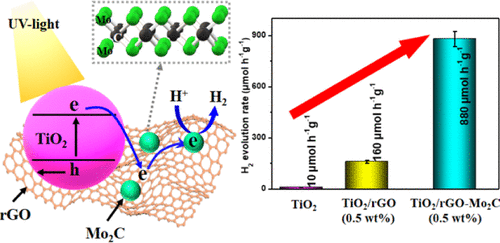当前位置:
X-MOL 学术
›
ACS Sustain. Chem. Eng.
›
论文详情
Our official English website, www.x-mol.net, welcomes your
feedback! (Note: you will need to create a separate account there.)
In Situ Synthesis of Mo2C Nanoparticles on Graphene Nanosheets for Enhanced Photocatalytic H2-Production Activity of TiO2
ACS Sustainable Chemistry & Engineering ( IF 7.1 ) Pub Date : 2021-03-02 , DOI: 10.1021/acssuschemeng.0c08903 Jinfeng Liu 1 , Ping Wang 1, 2 , Jiajie Fan 3 , Huogen Yu 1, 2 , Jiaguo Yu 4
ACS Sustainable Chemistry & Engineering ( IF 7.1 ) Pub Date : 2021-03-02 , DOI: 10.1021/acssuschemeng.0c08903 Jinfeng Liu 1 , Ping Wang 1, 2 , Jiajie Fan 3 , Huogen Yu 1, 2 , Jiaguo Yu 4
Affiliation

|
Molybdenum carbide (Mo2C) has been proven to be the most promising candidate for the H2-evolution cocatalyst due to the similar H+-adsorption ability to Pt. However, owing to its limited electrical conductivity, the Mo2C-modified photocatalysts usually exhibit a low H2-evolution performance. Considering the perfect electron mobility of graphene nanosheets, in this article, Mo2C nanoparticles (ca. 5 nm) were in-situ and evenly grown on the reduced graphene oxide (rGO) to prepare the graphene-modified Mo2C (rGO-Mo2C) nanoparticles to improve the photocatalytic hydrogen-generation rate of TiO2. Herein, the rGO-Mo2C is obtained by the direct calcination of graphene oxide (GO) as the carbon source and (NH4)6Mo7O24 at 800 °C, which is further coupled with the TiO2 to synthesize the efficient TiO2/rGO-Mo2C photocatalyst. The greatest hydrogen-generation activity of TiO2/rGO-Mo2C achieved 880 μmol h–1 g–1 (AQE = 2.64%), which was 5.5 and 88 times higher than that of TiO2/rGO and TiO2, respectively. The boosted performance of TiO2/rGO-Mo2C can be attributed to the synergetic action that the rGO nanosheets can act as electron media to promote the photoelectron transfer, and the Mo2C nanoparticles can serve as active centers to improve the interfacial hydrogen-generation reaction. This work can provide a new synthesis strategy for the design of efficient cocatalysts for potential applications.
中文翻译:

石墨烯纳米片上原位合成Mo 2 C纳米颗粒增强TiO 2的光催化H 2生成活性
由于与Pt具有相似的H +吸附能力,碳化钼(Mo 2 C)被证明是H 2-演化助催化剂的最有希望的候选者。然而,由于其有限的电导率,Mo 2 C-改性的光催化剂通常表现出低的H 2释放性能。考虑到石墨烯纳米片的完美电子迁移率,在本文中,将Mo 2 C纳米粒子(约5 nm)在还原的氧化石墨烯(rGO )上原位均匀生长,以制备石墨烯修饰的Mo 2 C(rGO- Mo 2 C)纳米颗粒提高TiO 2的光催化制氢速率。此处,rGO-Mo 2 C是通过在800°C下直接煅烧作为碳源的氧化石墨烯(GO)和(NH 4)6 Mo 7 O 24,然后进一步与TiO 2偶联而合成的。高效的TiO 2 / rGO-Mo 2 C光催化剂。TiO 2的最大的氢生成活性2 / RGO钼2 C ++实现880微摩尔ħ -1克-1(AQE = 2.64%),这比的TiO更高5.5和88倍2 / RGO和TiO 2分别。TiO 2 / rGO-Mo的增强性能2 C可以归因于协同作用,即rGO纳米片可以充当电子介质来促进光电子转移,而Mo 2 C纳米颗粒可以充当活性中心来改善界面氢生成反应。这项工作可以为潜在应用的高效助催化剂的设计提供一种新的合成策略。
更新日期:2021-03-15
中文翻译:

石墨烯纳米片上原位合成Mo 2 C纳米颗粒增强TiO 2的光催化H 2生成活性
由于与Pt具有相似的H +吸附能力,碳化钼(Mo 2 C)被证明是H 2-演化助催化剂的最有希望的候选者。然而,由于其有限的电导率,Mo 2 C-改性的光催化剂通常表现出低的H 2释放性能。考虑到石墨烯纳米片的完美电子迁移率,在本文中,将Mo 2 C纳米粒子(约5 nm)在还原的氧化石墨烯(rGO )上原位均匀生长,以制备石墨烯修饰的Mo 2 C(rGO- Mo 2 C)纳米颗粒提高TiO 2的光催化制氢速率。此处,rGO-Mo 2 C是通过在800°C下直接煅烧作为碳源的氧化石墨烯(GO)和(NH 4)6 Mo 7 O 24,然后进一步与TiO 2偶联而合成的。高效的TiO 2 / rGO-Mo 2 C光催化剂。TiO 2的最大的氢生成活性2 / RGO钼2 C ++实现880微摩尔ħ -1克-1(AQE = 2.64%),这比的TiO更高5.5和88倍2 / RGO和TiO 2分别。TiO 2 / rGO-Mo的增强性能2 C可以归因于协同作用,即rGO纳米片可以充当电子介质来促进光电子转移,而Mo 2 C纳米颗粒可以充当活性中心来改善界面氢生成反应。这项工作可以为潜在应用的高效助催化剂的设计提供一种新的合成策略。











































 京公网安备 11010802027423号
京公网安备 11010802027423号